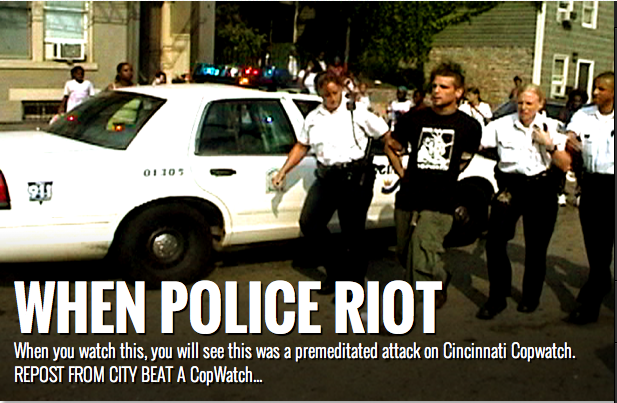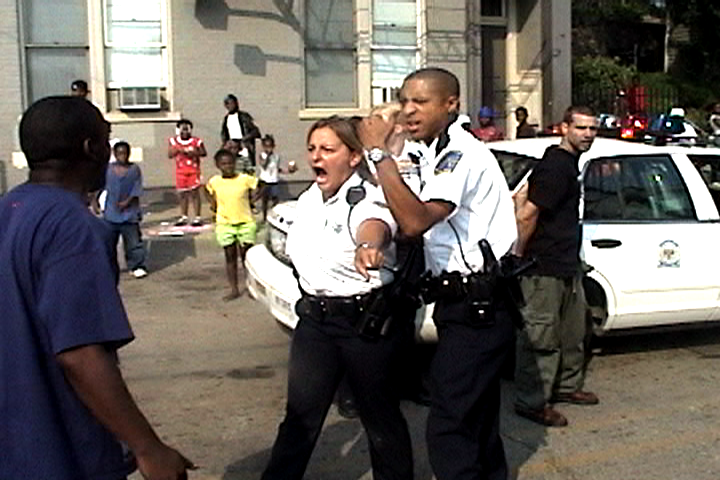
When you watch this, you will see this was a premeditated attack on Cincinnati Copwatch.
REPOST FROM CITY BEAT
A CopWatch volunteer’s videocamera last week helped prove his innocence in court.
After testimony by Jacob Crawford and the two Cincinnati Police officers who arrested him, Hamilton County Municipal Judge Cheryl Grant acquitted Crawford of obstructing official business.
“After weighing the credibility of the witnesses, the court finds that the state did not prove its case on this issue and finds the defendant not guilty,” Grant said.
Crawford, a CopWatch organizer in Berkley, Calif., attended a block party sponsored by Cincinnati CopWatch. The organization had a permit to block part of East Clifton Avenue in Over-The-Rhine from noon-8 p.m. July 26. When a police officer needed help nearby, two squad cars drove into the block party; Crawford was arrested for blocking their path.
The prosecution presented a tape from a cruiser that followed one driven by Officer Robin Williams. The tape shows the cruisers went around a barricade and into the block party. Near the barricade, as the cruisers approached, a man can be seen on the left side of the road motioning for police to slow down.
Williams said she didn’t see the man. What she says she saw, as the video depicts, was a large group of people in the street, which she figured was related to the assistance call.
“I wasn’t aware there was a block party,” Williams said.
Crawford was standing in the road, a videocamera to his face. Williams’ vehicle veered to the left to avoid him. She and Officer Jody Dillinger both testified that Crawford tried more than once to move in front of their vehicle.
Williams testified that she stopped three times because of Crawford. But she later said that after the first stop, she told Dillinger to arrest him. The tape shows that after Dillinger left the car, Crawford took several steps away from her. Within seconds, he threw his hands in the air and lay on the ground and Dillinger got on top of him and handcuffed him.
Defense attorney Paul Laufman presented videotape shot by Crawford. It shows an oncoming police cruiser blowing its air horn and veering to the right of the camera’s perspective. The passenger door opens and Dillinger jumps out. Then the camera shakes for a couple of seconds and settles, showing Crawford on his stomach and Dillinger on top of him.
On the witness stand, Crawford admitted to hearing the sirens but didn’t know what they were for.
“Sirens are so common in Over-the-Rhine, I just ignored it,” he said.
Crawford said he didn’t see the lights until the car was almost on top of him. The distance between him and the barrier was roughly 75 yards; and with the large crowd, he said, his view was blocked.
Crawford also testified he assumed the police wanted to check the permit for the block party and that’s why he didn’t move at first. He said he just turned on his camera and started filming.
Laufman argued that the camera hindered Crawford’s view to the extent that he couldn’t realize what was going on.
Crawford said he wasn’t running, but getting out of the way because he thought Dillinger was after somebody else.
“When I realized it was me, that’s when I put my hands up and got on the ground,” he said. “I was like a deer in the headlights.”
Crawford’s videocamera — still running when it was placed on the front seat of the police cruiser — contradicted Dillinger’s testimony. Dillinger had testified that Crawford moved in front of the vehicle. But when she was reprimanding him in the car, she said the opposite.
“You just stood there,” Dillinger said. “You were running the camera!”
Laufman argued that obstruction of official business requires an act.
“The officer herself said in the video that he just stood there,” Laufman said. “For that, there was no act.”
Laufman also asked both officers if they’d noticed any children. Both testified that they were too frightened and on edge to notice any of the age groups.
But on Crawford’s tape, Dillinger said, “You could have gotten one of those kids killed.”
In closing arguments, Laufman argued that Crawford did nothing wrong.
“His intent was only trying to film, not impede the officers,” Laufman said. “As we watch his camera as the cruiser approaches, it veers to the left and we can see that the camera does not move from its original position. We would submit to the court that he did no act. He stood where he was.”
The judge agreed.
“The court understands the officers’ emotions,” Grant said. “The court also understands that Mr. Crawford was attempting to video the officers. … When officers respond to an emergency, the officers are expected to be able to deal with obstacles.”
After the trial, Crawford said he believes police mishandled the situation.
“A lot of these officers do not know what it is to live in a poor black community,” he said. “They are not aware of their struggle and history. It’s not so much about help as it is about the hunt.”
Police Chief Tom Streicher has denied CopWatch’s application for another block party. Streicher wrote that during the July 26 party, officers were unable to respond to an assistance call because the “emergency lane of travel through the block party had not been maintained, as required by the conditions of the permit.”
But that contradicts Capt. James Whalen, who earlier said the westbound lane of traffic was kept clear and apologized that police had frightened residents
